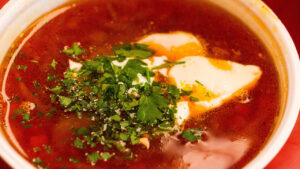Putin’s lost battle for borscht and other food fights

By Howard Chua-Eoan
WHEN this year’s list of the World’s 50 Best Restaurants is announced on Tuesday, there will be lots of talk of the signature dishes and inimitable styles of the top spots. Central in Lima creates its singular cuisine from the most astonishing produce of Peru — from Amazonian piranha to Andean potatoes to globular algae plucked from forest rivulets. Alchemist in Copenhagen and Mugaritz in San Sebastian continue to push the radical rethinking of dining that El Bulli began on Spain’s Costa Brava. The Chairman in Hong Kong innovates Cantonese tradition — the steamed flower crab, the smoked goose, the rice broth with lobster — with such elan that lesser establishments have little choice but to imitate to stay current.
Creativity and craft establish the identities of these restaurants. Foodies like me make pilgrimages to them at great expense and with much gusto because the experiences can’t be replicated anywhere else.
Food’s also been used to establish broader identities — a sensitive subject explored by Anya von Bremzen in her incisive, spirited and mouthwatering new book National Dish: Around the World in Search of Food, History and the Meaning of Home. Thus, we’ve come to associate pizza and pasta with Italy, sushi and ramen with Japan, tapas and jamon with Spain and so on. These national signature dishes are so intertwined with the identities of their countries of origin that they are an impetus for patriotism. Some governments have won UNESCO recognition for the uniqueness not only of specific dishes but of whole swaths of kitchen culture: Neapolitan pizza, Singaporean hawker stands, the traditional Japanese meal of rice, fish and soy, the cooking of Mexico, French gastronomy. It’s become a veritable certificate of ownership over the interpretations and appropriation of dishes.
Indeed, casus belli. Less than two months after Vladimir Putin invaded Ukraine in 2022, UNESCO issued an emergency recognition of borscht as Ukrainian. Kyiv’s first successful counteroffensive was cultural. Moscow was apoplectic. In her epilogue, Von Bremzen, who grew up in Moscow, anguishes over whether Russians and Ukrainians will ever serve it to each other again. The traditionally beet-red soup had once been happily shared by all former Soviets. Putin made it Russia’s to lose.
At heart, designated national dishes are as much propaganda as palate-pleasers. Many aren’t even intrinsic to the modern polities that claim them: Pizza was the despised scrap of burnt dough eaten only by poor Neapolitans; ramen began with Chinese migrants in the port of Yokohama; tapas truly emerged only in the 1920s. But they’ve become tools in nation building: the alimentary comforts of home can be exploited to define a homeland.
Food can be used not only to distinguish, but to exclude, as Von Bremzen reminds us in her book. The quarrelsome regions of Spain may be unified over jamon — the undeniably delicious iberico ham — but pork reigns supreme because in the late 15th century Isabella the Catholic’s Spanish Inquisition started using pig meat (and a suspect’s aversion to it) to root out fake Christian converts. Those crypto-Muslims and crypto-Jews then faced burning at the stake.
The territoriality of the national dish, however, underestimates the fluidity of cuisine. Our image of Italian food would not exist were it not for tomatoes — originally from Mexico. Indeed, the sumptuary feasts of the peninsula were likely the product of successful migrant communities in North and South America. They turned meager traditions into tables overflowing with the New World’s plenteous resources. Italy, still freshly united at the end of the 19th century and lacking national cohesion, eagerly absorbed this reimagination of its cuisine by formerly poor huddled masses yearning to be fed.
Stately plump gourmands in posh eateries owe a lot to people who have lost everything, to refugees trying to find home. We are what we eat because we allow them to share ours.
In truth, no kitchen is an island. At a recent culinary conference held in London, Mohamad Orfali, the chef of Orfali Bros in Dubai, recalled how his mother used to serve up a popular sweet cream treat in their native Aleppo, Syria. Heytaliyeh was always presented in a porcelain bowl and eaten with a Chinese-style ladle. Orfali said his research points to its origin with a migrant family from Central Asia, perhaps from an area controlled or influenced by China. They substituted milk curds for the tofu unavailable in their new home. Now, heytaliyeh is a delight magnified by rose water and pistachios. The ladle and bowl are a reminder to be grateful for a gift from afar. — Bloomberg Opinion




